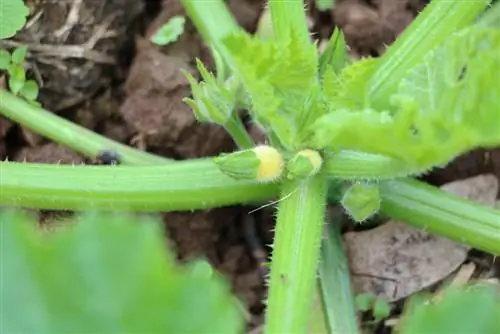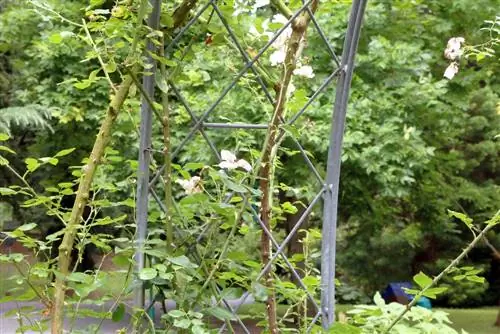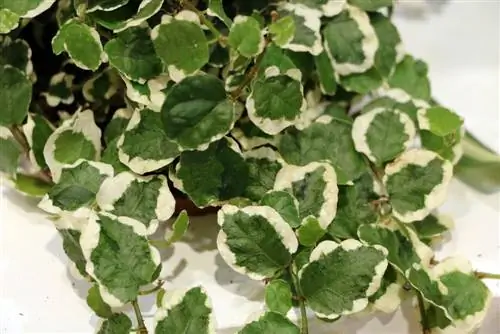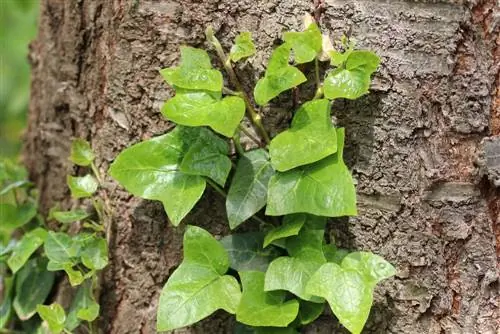- Author admin [email protected].
- Public 2023-12-17 03:39.
- Last modified 2025-06-01 06:48.
Roses and climbing roses in the garden are a wonderful addition, but every hobby gardener knows the pain of caring for them when they get to the thorns. However, many beautiful rose varieties have now been bred that have little to no thorns. The term thorns is used more colloquially here and the botanist speaks of spines.
The graceful roses and climbing roses are a beautiful decoration on the terrace or in the garden. However, hobby gardeners are often afraid to plant them in the garden because of their thorns. Especially if there are small children in the family, these rose bushes can quickly become dangerous for the little ones. But there are now many types of roses that have little to no thorns and are therefore a good alternative for every garden lover. This means that caring for and cutting the plants can be done painlessly.
Popular varieties
Roses and climbing roses without thorns have long since established themselves in local gardens. They are just as easy to care for and eye-catching as their spiky sisters, but are easier to handle due to the lower risk of injury. A special feature among the climbing roses are the ramblers, which are characterized by thin, long and particularly flexible shoots. Since not all of the many types of roses and climbing roses can be presented without thorns, this is a small excerpt:
English Rose Graham Thomas
- amber yellow, heavily double, 9 - 11 cm large flowers
- strongly scented of tea roses with a slight note of violet
- great flowering, blooms several times a year
- upright growth
- becomes 120 cm and higher, also grows in width
- very hardy
The English rose Graham Thomas is an old variety that fits into any ornamental garden with its ancient beauty. This is why it is one of the most popular English roses and can also be found in many local gardens.
Rambler Rose Ghislaine de Feligonde
- yellow-apricot colored, double, 3 - 5 cm large flowers
- glossy, dense, medium green foliage
- slightly fragrant and often flowering
- Climbing rose up to 4 meters high
- frost hardy
The historic variety Rambler Rose Ghislaine de Feligonde is particularly suitable for individual positions or loose hedges due to its growth. Since it also tolerates semi-shady places, it can be planted in many locations in the garden. Slightly susceptible to powdery mildew and sooty mold, but with good care it regenerates on its own.
English Rose Jubilee Celebration
- salmon pink, heavily double, 11 - 13 cm large flowers
- fruity, strong scent, reminiscent of raspberries and lemons
- blooms several times a year
- Bush grows up to 120 cm high and overhangs
- hardy
The English Rose Jubilee Celebration was named to commemorate the golden anniversary of the coronation and is considered one of the most beautiful English roses. Its elegance is characterized by the fact that each of its large flowers stands alone above its foliage. The Jubilee Celebration is considered a very he althy rose with few susceptibilities.
Rambler Rose Malvern Hills
- light yellow, semi-double, 4 - 5 cm large flowers
- dark green, shiny, small leaves
- slightly nutty scent
- blooms several times from May to the end of August
- bushy-wide, climbs up to 3.5 meters high
- a south wall is the ideal location
- Winter protection desired in very frosty temperatures
The Rambler Rose Malvern Hills, which was named after a hilly landscape, does not require any climbing or climbing aids. The climbing rose is considered to be very robust and not very susceptible to the known rose diseases.
English Rose Carolyn Knight
- golden yellow, heavily double, 7 - 9 cm large flowers
- smells warm and sweet like honey
- blooms several times a year
- wide bush up to 2 meters high
- strong, upright growth
- hardy
The English Rose Carolyn Knight developed over the years from the well-known “Summer Song”. Due to its straight growth, it is suitable as a border behind smaller plants.
Rambler Rose Maria Lisa
- dark pink to red, non-double, 3 - 4 cm large flowers
- scentless
- blooms only once a year
- Blossoms last a very long time until the first frost
- Climbing rose that grows up to 5 meters high with a trellis
- not suitable as a container plant
- hardy

The Rambler Rose Maria Lisa is particularly suitable for pergolas or on house walls with climbing aids. She also likes to pull herself up on nearby trees or fences. Unfortunately it is susceptible to mildew and lice and for this reason it should be airy and free with good air circulation.
Climbing Rose Violet Blue
- violet-blue-centered white, semi-double, 3 - 4 cm large flowers
- slightly faintly fruity scent
- Flowers only appear from the second year onwards
- only once a year but blooms profusely in early summer
- Climbing rose, grows up to 5 meters high
- has a typical multiflora appearance, which means it is very vigorous
- can be cultivated not only as a climbing rose, but also in bush form
- hardy
The violet blue climbing rose requires a lot of care and must be regularly supplied with plant strengthening agents as it is susceptible to powdery mildew and sooty mildew. For this reason, the location should also be chosen so that it is very airy so that rainwater dries off quickly on the leaves and it is not under trees (increased droplet fall).
Bedding rose Lovita 2014
- dark red-white, semi-double, 4 -6 cm large flowers
- dark green leaves
- light scent
- blooms several times a year with a long flowering period
- small 40 - 60 cm high bush
- also suitable as a pot plant
- hardy
The floribunda rose Lovita 2014 is a completely new rose breed and has only been on the market since 2014. In addition to the garden bed, where the rose plants look good as a large group, they are also a real eye-catcher on the balcony and terrace. It also shows little susceptibility to powdery mildew and black mold.
English Rose Wollerton Old Hall
- soft yellow, heavily double, 8 - 10 cm large flowers
- strong and intense scent of myrrh
- blooms several times a year
- reaches a height of 120 - 150 cm, also grows strongly in width
- hardy
The scent of the English Rose Wollerton Old Hall is very dependent on the weather and spreads particularly well in hot, dry summers. To enjoy the scent, choose a location on a seating area in the garden or near the terrace. This English rose is a very he althy plant that shows little susceptibility to pests or diseases.
Tip:
The term thorns was already used colloquially incorrectly during Sleeping Beauty's time. Botanists refer to roses as spines because they are growths from the bark. Thorns, on the other hand, arise from the wood. Therefore the fairy tale should actually be rewritten in Stinging Beauty. However, since the term thorns has also become established among many hobby gardeners, it is still used here.
Care tips
- sunny to partially shaded location
- airy, sometimes windy
- so the leaves of the plant can dry quickly after dew or rain
- humus- and nutrient-rich and permeable soil
- Make dense soil more permeable with compost, sand or gravel
- Clay soils are a good substrate for roses
- Mix in commercial clay powder
- avoid heavy, impermeable soils
- Use long-term fertilizer for roses
- fertilization takes place from early spring after frost until the last fertilization in the summer months
- Autumn is the ideal planting time for roses of all kinds
- If it is planted in spring, the flowering will most likely be very small or even non-existent that year
- Make sure roses and climbing roses without thorns have constant moisture
- no waterlogging
- Do not water plants from above over the leaves and flowers
- avoid prolonged drought
- remove dead shoots and wilted flowers in autumn
- Only cut back rose bushes if they get too big and wide
- cut down new side shoots in spring
- Remove dead wood caused by winter damage
Conclusion
Roses and climbing roses are an eye-catcher in every well-kept garden. There are now many beautiful species that do not have thorns and are therefore even easier to care for because they are less dangerous. Yellow, red, pink or salmon-colored and white roses that couldn't be more beautiful bloom on the terrace or in the garden all summer long. Families with small children in particular are increasingly discovering varieties of roses and climbing roses without thorns, as they pose fewer risks for the little ones. The grace and beauty of roses and climbing roses remain, despite the missing, usually painful thorns.






